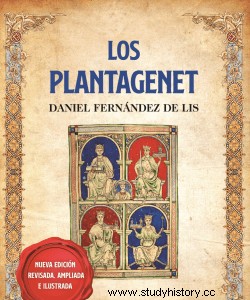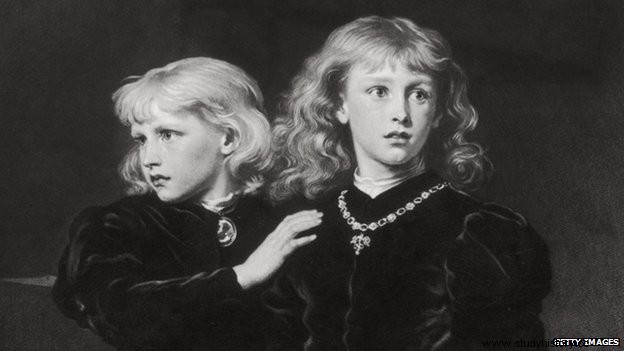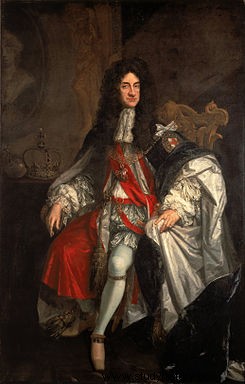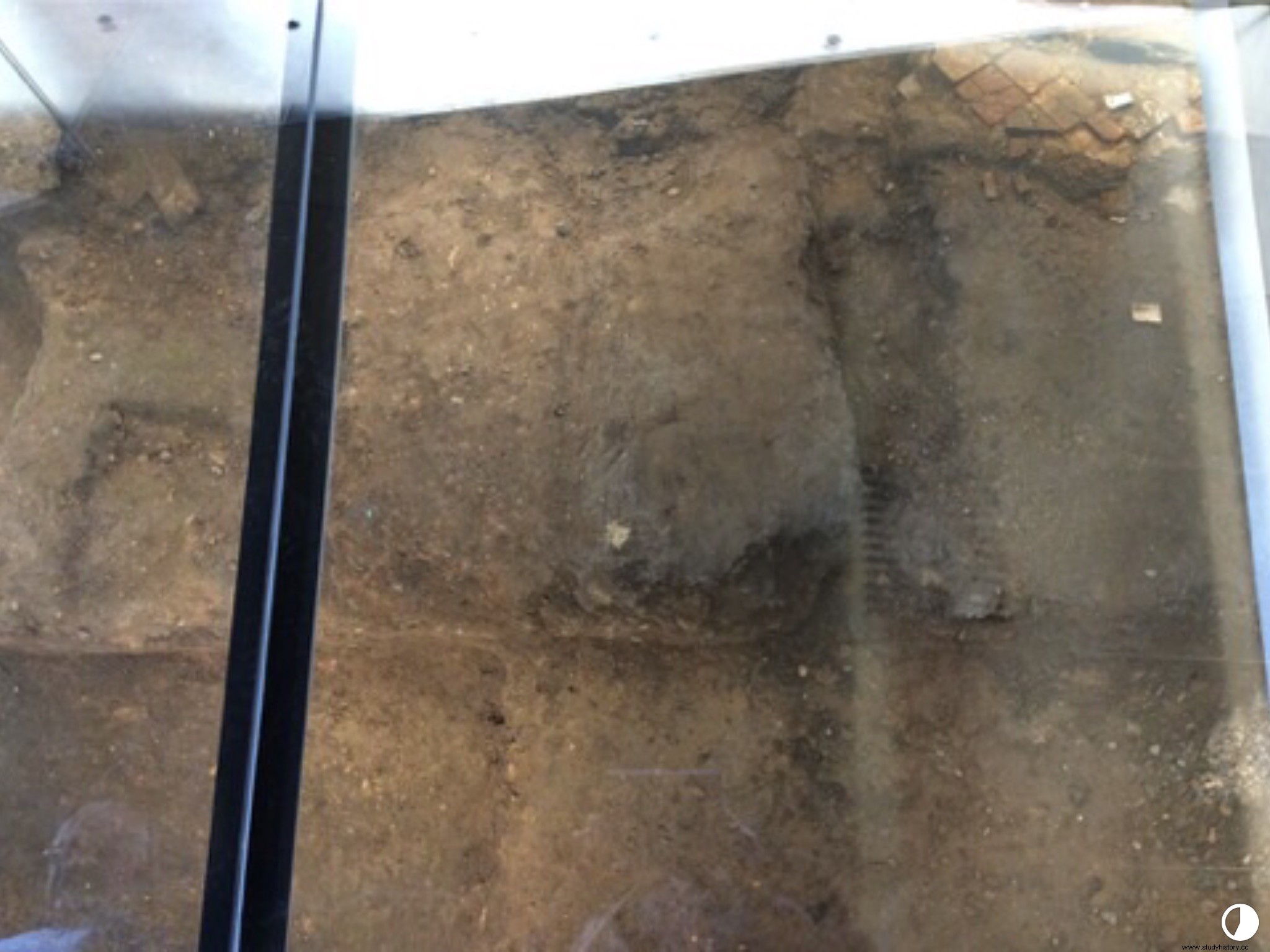Entry taken from the book The Plantagenet.

An urn in the area of Westminster Abbey in which various members of the English royalty rest is reserved for King Edward V and his brother Richard, Duke of York. So far, nothing unusual:two people from the royal family buried among so many relatives and colleagues.
The question begins to be more surprising when you read the legend that says on the tombstone where they rest:
Here lie the remains of Edward V, King of England, and Richard, Duke of York. These brothers were confined in the Tower of London and there they were suffocated with cushions and buried without any ceremony by order of their perfidious uncle Richard III the Usurper. His long-sought and longed-for bones were found and identified without a doubt, on July 17, 1674, 191 years later, in the rubble of the stairs (which would later lead to the White Tower) deeply buried there. The very compassionate Prince Charles II, lamenting his tragic fate, arranged for the unfortunate princes to rest among the monuments of his predecessors in 1678, in the thirtieth year of his reign.
And the matter becomes more enigmatic if, after reading the transcribed legend, one realizes that the tombstone is dedicated to those known as Princes of the Tower of London , whose fate remains today one of the greatest mysteries in the history of England. How is it possible that five hundred years later what happened to two princes who have apparently been buried for more than three hundred years in Westminster Abbey continues to provoke a heated controversy?
To answer this question it is necessary, firstly, to remember what is known as the mystery of the Princes of the Tower of London and, secondly, to unravel what happened in the year 1674 to determine whether or not the remains found are those of the two boys.

Regarding the first aspect, although the entry linked narrates the matter in detail, we can remember here that Eduardo and Ricardo were sons of King Eduardo IV. After his death in 1483, when the young Edward V was on his way to London to be crowned, he was intercepted by his uncle Richard of Gloucester, who installed the boy in the Tower of London (a royal residence and not a prison at the time). Shortly after his little brother Richard joined him, while his uncle managed to get Parliament to declare both boys illegitimate and to name him king of England, he ascended the throne with the name of Richard III. Soon after, the princes disappeared without a trace. For centuries, due largely to the works of Shakespeare and Thomas More, Richard III was unanimously held responsible for the death and disappearance of his nephews. But in recent times various movements have emerged that claim the figure of the vilified king and try to exculpate him from the death of the princes.
Regarding the question of whether the remains found in the Tower in 1674 are those of the two young men, in order to answer it, it is necessary to narrate how such a discovery took place. Various sources of the time refer to this unique event.
An official of the Tower, named John Gibbon, relates that on July 17, 1674, the remains of Edward V and his brother were discovered and that he himself manipulated the skull of the king and another smaller one. For his part, the Chief Surgeon to King Charles II, John Knight wrote:"While excavating two stone steps in the White Tower leading from the King's apartments to the chapel, the bodies of two boys were found in what appeared to be a wooden chest, assumed to contain the bones of King Edward and his brother Richard, Duke of York. By order of King Charles II they were placed in a marble urn and deposited among the royal family alongside those of Henry VII at Westminter.
Another, anonymous account cites Knight as its source, reiterates what Knight said, and adds that the bones seemed proportional to those of the princes' age (thirteen and eleven years). The skull of one of them was intact and the other was broken, as were many of the other bones and the chest itself, due to the violence of the workers, who handled the rubble and bones indiscriminately.
A final source, also anonymous and undated, claims to have witnessed the discovery of the bones of the princes "criminally murdered by Richard III" and points out that they were small bones of children in their teens, mixed with bits of rags and velvet. He concludes that being totally identified with the remains of the princes, they were carefully separated in a stone container.

From the transcribed stories it follows that, despite that the discovery of the bones of what were apparently two boys must have been quite an event that raised interest, they were initially thrown into the rubble and only later recovered, so many of the bones may have been lost or shattered.
The very description of the way in which the bones were discovered puts at least in quarantine that they were "undoubtedly" the remains of the princes. But there are other elements that also do not help to give credibility to the story. For example, two stories close in time to the disappearance of the boys, that of Thomas More and that of John Rastell, narrate how the remains of the princes were removed from the Tower after death and buried elsewhere or thrown into the Canal de the stain. Other sources suggest that the princes were secretly released and survived, which, in addition to confirming that it would not be their remains that are in Westminster, would add more spice to their enigma... but that's another story.
On the other hand, we cannot isolate the discovery of the bones from the political moment in which it occurred. In 1674, Charles II reigned in England, in whom the monarchy had been restored after the period of "republicanism" constituted by the protectorate of Oliver Cromwell. For the reigning monarch, who was experiencing difficulties in his relations with Parliament, it was propagandistically important to remember the fate that awaited the usurpers (Richard III and Cromwell) who assassinated the legitimate kings (Edward V the first and the king's own father, Carlos I, the second). The message to members of Parliament was to think twice before opposing the legitimate monarch, in this case Charles II.
It was not the first time that bones appeared in the Tower of London, nor that someone insinuated that it was the princes, but it seems that in this case King Charles II was interested greatly that it was made public that the remains found in 1674 were those of the two young men, and this despite the fact that there was no evidence whatsoever to prove it.
Perhaps wanting to definitively solve the enigma, in 1933 the bones were unearthed to try to identify them. The study was entrusted to the eminent Professor William Wright, assisted by Lawrence Tanner who, unlike the professor's impressive credentials, lacked any qualifications for the task at hand. Rubble and animal bones were found among the remains contained in the urn, but two incomplete human skeletons were also identified. It is possible that some of the human remains disappeared or were stolen as relics and replaced by animal bones, but in any case Wright and Tanner concluded that they were the remains of the Princes of the Tower of London and returned them to their urn.
But in 1955 another study was commissioned by a team of anthropologists and orthodontists. Although the team did not have access to the remains but only to Wright's data and notes, this was enough to establish that not only had the age of the deceased not been proven, but that not even a serious attempt had been made. to determine its sex. They highlighted other deficiencies in the 1933 study and concluded that it could neither be confirmed nor ruled out that it was the princes.

In recent years, as many voices cry out for that the remains be unearthed again to carry out a study with the most modern methods (including a DNA examination) it has come to pass that a serious and multidisciplinary scientific study led to the discovery of other remains that had been lost since more or less the same time and belonging to someone closely associated with the princes:their alleged assassin Richard III, whose skeleton was found in a car park in Leicester (see the link for the process that led to its discovery). The promoter of this process to find Richard III has offered to launch a similar project with the Princes of the Tower of London, but for now that initiative will have to wait.
Daniel Fernandez deLis. What Shakespeare didn't tell you about the Wars of the Roses
Matt Lewis. The survival of the Princes in the Tower
